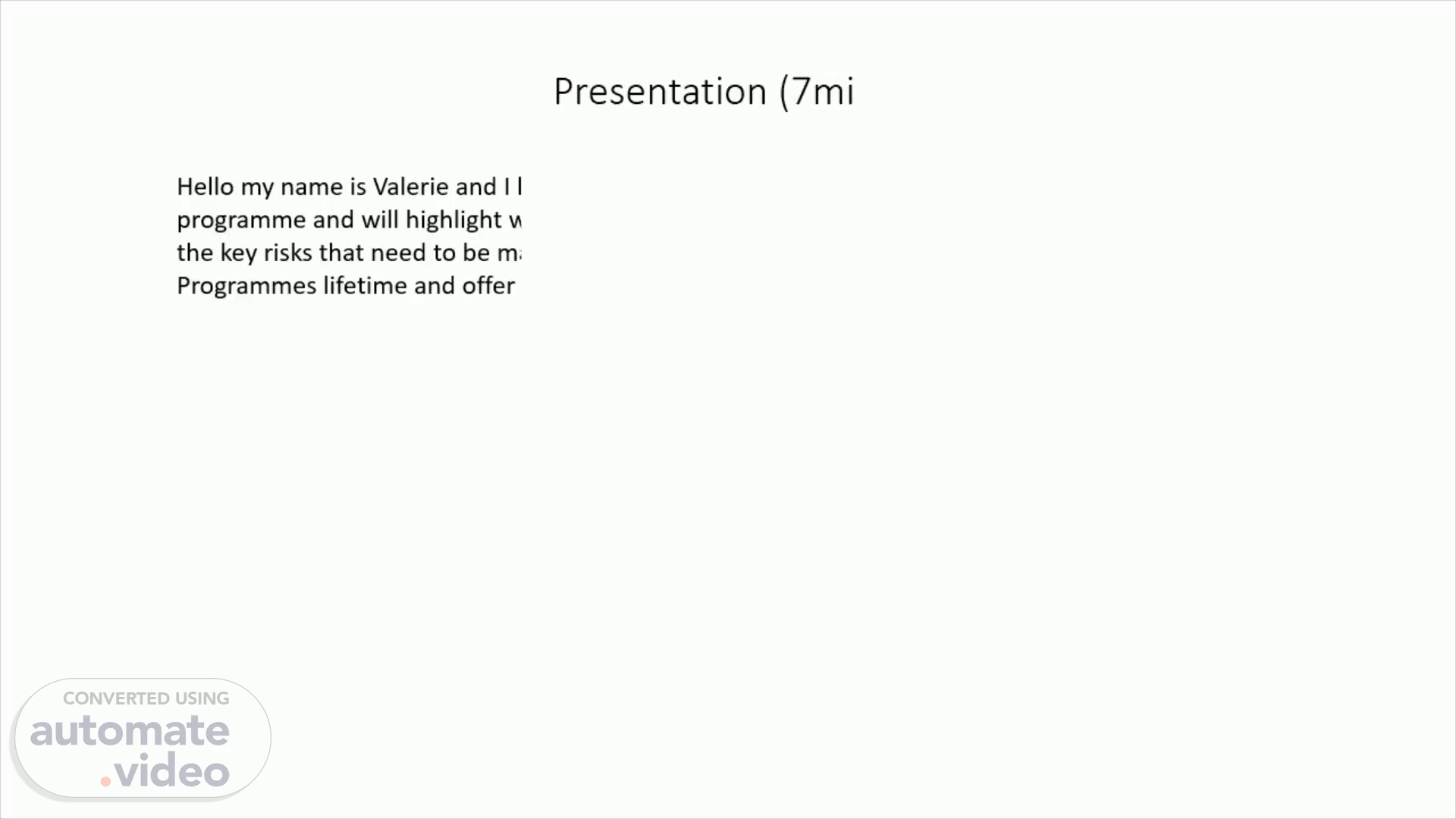
Presentation (7mins)
Scene 1 (0s)
Presentation (7mins). Hello my name is Valerie and I have chosen to look at the PEOPLE component of the planned programme and will highlight what I believe are the key tasks to be delivered for this component; the key risks that need to be managed at the programme -initiation phase and then risks over the Programmes lifetime and offer some suggestions on how these risks may be mitigated..
Scene 2 (19s)
Tasks to be delivered Tasks How 1. Establish the status quo of the current workforce against the current work programme Roles and responsibilities Capacity Skills Identify inescapable, challenges, bottlenecks etc 2. Consider position re current staff – business continuity Wellbeing Strategy Recognition initiatives Succession Planning (perhaps mentor roles for new staff) Confirm only working on inescapable in interim Enhance team work/collaboration 3. Establish future workforce requirements and associated Develop Plan/career path to connect the business strategy to the talent, resource strategies Engagement with Head of Organisation Change and Heads of Operations What skills needed - when - how many 4. Review/develop required strategies in light of programme and operational future needs Recruitment and Retention – promoting benefits of NICS Diversity and Inclusion Strategy to get the best workforce Learning and Development Programme (consider career pathways) 5. Establish clear communication and engagement strategies – staff, TU, heads of all other groups Keep everyone informed Horizontal and vertical integration = critical for success = minimizes gossip etc 6. Create KPIs or data for monitoring purposes and continuous improvement Allows for progress to be monitored 7. Ensure compliance with legal, regulatory and Departmental requirements including governance and initiatives from the climate change act.
Scene 3 (1m 6s)
Initial Risks to Programme 1 People Not considering ot taking action to address the Well Being of current staff decreased staff morale and engagement, increased turnover and recruitment costs, decreased productivity and performance, potential negative impact on departments reputation. It can also lead to: increased stress, burnout, and health issues among employees; legal and compliance risks, such as potential lawsuits related to workplace health and safety. harder to address with hybrid working Reward and Recognition – reminders of work they have achieved Wellbeing Strategy Worklife Balance initiatives L&D programme Meaningful career path Effective performance management Consider AWPs.
Scene 4 (2m 37s)
3 People Failure to be inclusive and have diverse workforce Limited perspectives and ideas: Without a diverse workforce, you may miss out on a wide range of perspectives, experiences, and ideas. This can hinder innovation and problem-solving. Decreased employee satisfaction and morale: Employees from underrepresented groups may feel undervalued or excluded if they don't see people like themselves in leadership positions or feel like their voices are not heard. This can lead to decreased job satisfaction and low morale. Poor decision-making: When there is a lack of diversity in your workforce, decision-making can become biased and limited. Having diverse perspectives can help in making more informed and balanced decisions. Reduced customer insights: If your workforce does not reflect the diversity of your customer base, it may be difficult to understand their needs, preferences, and expectations. This can result in a disconnect between your organization and its target audience. Legal and reputation risks: By not prioritising inclusion and diversity, the Department may face legal challenges regarding discrimination or unfair practices. mitigate bias from the recruitment process and establish a policy of equal opportunity for all applicants. Providing diversity training and education: Offer training programs to raise awareness about unconscious bias, cultural competence, and inclusive practices. This helps create a more inclusive and understanding work environment. Fostering a supportive culture: Develop policies and initiatives that promote inclusivity and diversity, such as employee resource groups, mentorship programs, and flexible work arrangements. Regularly measuring and monitoring progress: Implement metrics and surveys to assess diversity and inclusion efforts and track progress over time. This ensures accountability and identifies areas for improvement. Committing to diversity and inclusion at the leadership level: Encourage diverse representation in leadership positions and empower leaders to champion inclusive practices throughout the organization..
Scene 5 (3m 42s)
Risks to Life of Programme Mitigation actions 1 People Change in leadership/staff Clear vision to avoid confusion Action plans to ensure clarity of way forward Strong governance Communication L&D Programme to lesson anxiety 2 People Losing momentum Clear vision to avoid confusion Action plans to ensure clarity of way forward Strong governance Communication L&D Programme to lesson anxiety 3 People Focus drifting Clear vision to avoid confusion Action plans to ensure clarity of way forward Strong governance Communication L&D Programme to lesson anxiety Rewarding staff, reviewing progress, reiterating vision 4 People Fatigue/burnout of staff Wellbeing Programme 5 IT Changing IT/systems/automation IT experts to be within workforce 6 External Change to external factors eg Minister, change in climate change act Have sound data for decisions made, 7 Financial Further budget restrictions Take action as previously highlighted 8 Process Not maintaining/reviewing the TOM Regularly review the TOM Consult with Head of Org Change and Operations.
Scene 6 (4m 19s)
In all these work areas it is critical that the Head of Workforce Planning collaborates with Head of Org Change and Heads of Operations to synchornise and integrate delivery of the People, Policy and Operations Pillars as well as achieving the objectives of the OMP and executive priorities by ensuring there is the right mix of talent, technology and staffing models..